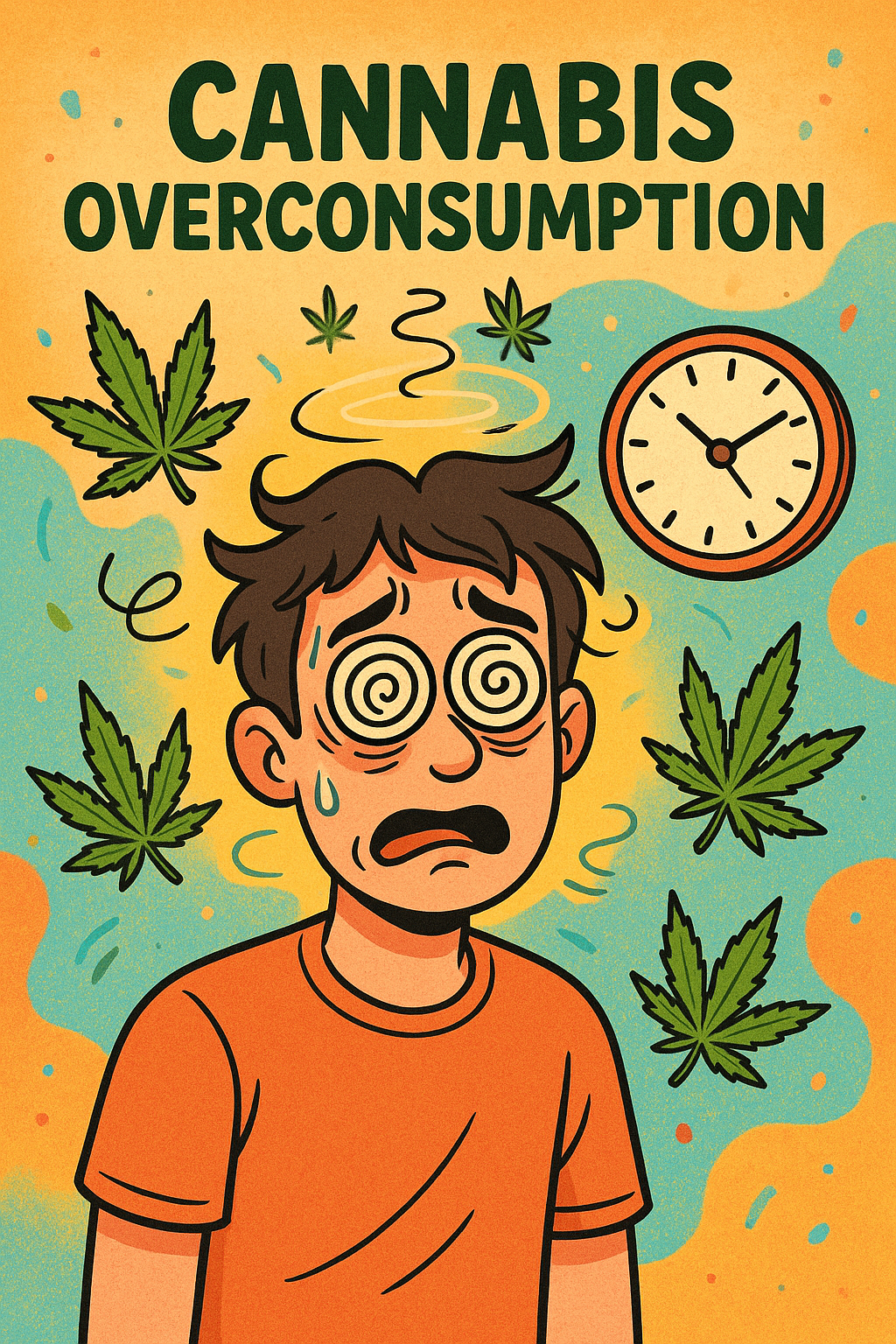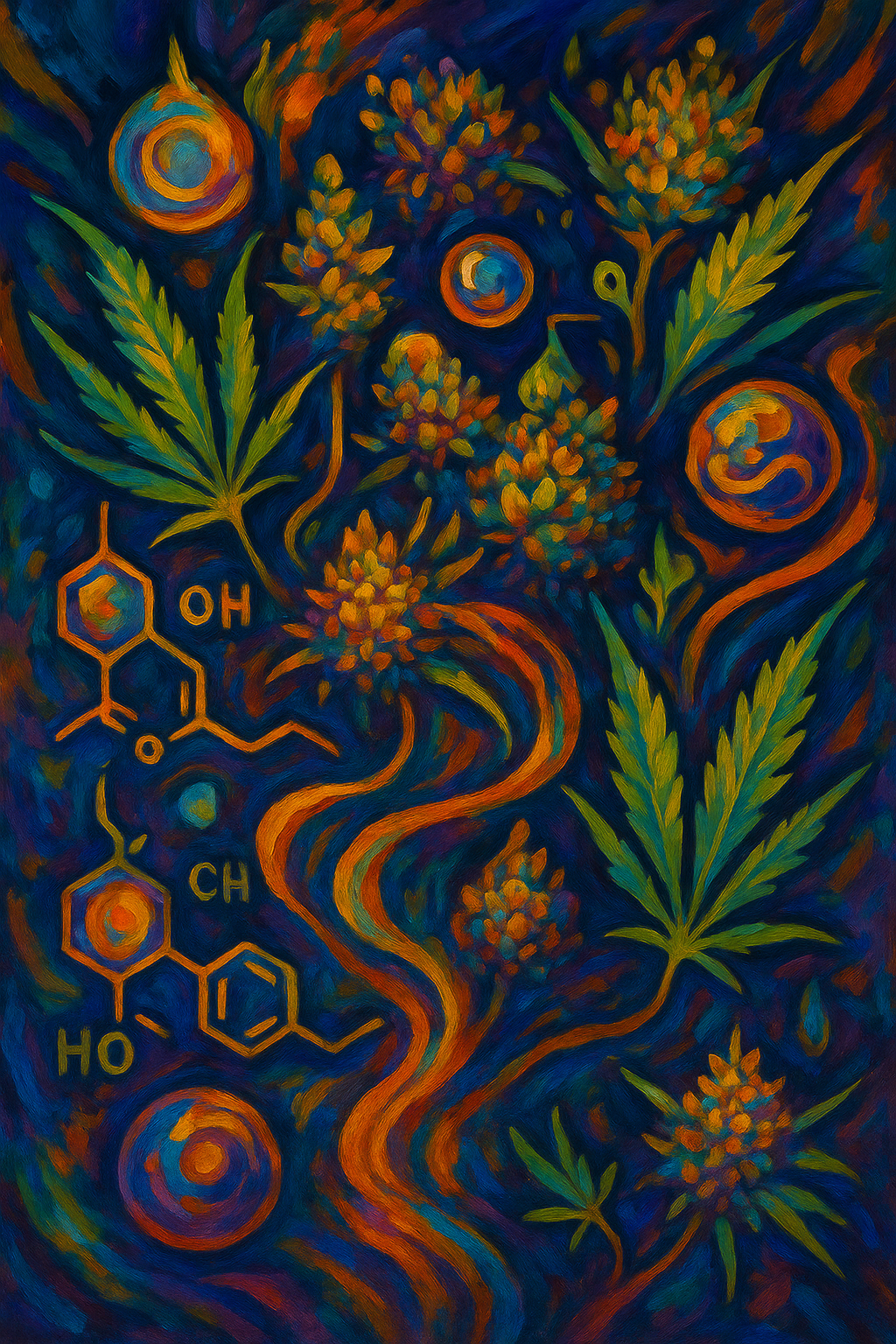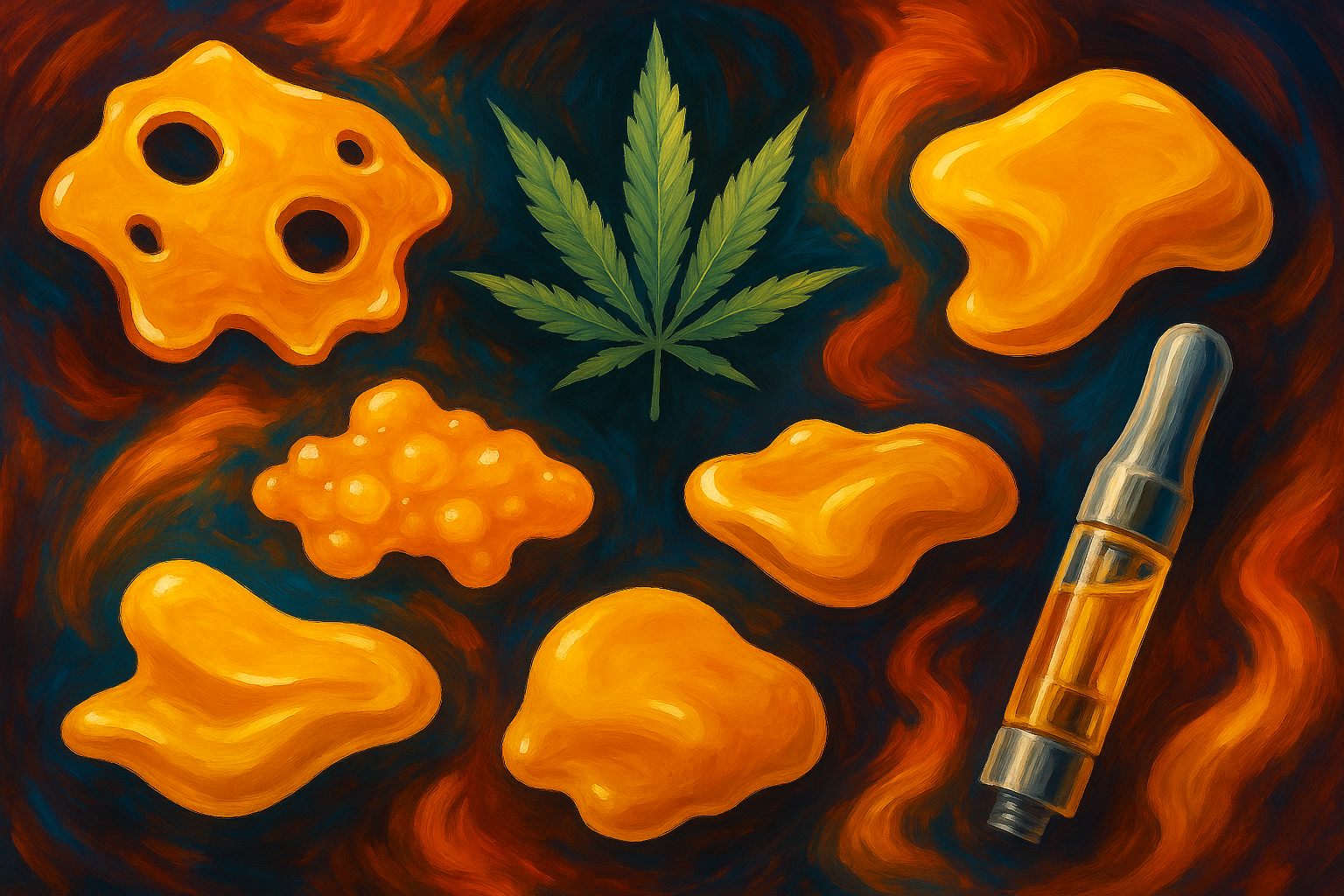The entourage effect represents one of cannabis science's most fascinating concepts, suggesting that the plant's numerous compounds work together to create effects greater than any single component could achieve alone[1][2]. This comprehensive analysis examines the scientific evidence, practical applications, and ongoing debates surrounding this phenomenon that has revolutionized how we understand cannabis therapeutics and consumer experiences.
The Roach: 5-Minute Quick Hit
What You Need to Know Right Now
The entourage effect is the theory that cannabis compounds—cannabinoids like THC and CBD, plus aromatic terpenes—work better together than individually[1][3]. Think of it like a symphony: each instrument (compound) contributes to a richer, more complex performance than any solo act could deliver.
Key Players: The main cannabinoids include THC (the psychoactive compound), CBD (non-psychoactive but therapeutic), and minor cannabinoids like CBG, CBC, and CBN[4][5]. Terpenes such as myrcene, limonene, and pinene provide aroma and their own effects[6][7].
The Science: First described by researchers Raphael Mechoulam and Shimon Ben-Shabat in 1998, the entourage effect suggests that "inactive" compounds can enhance the activity of primary cannabinoids[3][8]. Recent clinical studies, including a 2024 Johns Hopkins study, found that limonene combined with THC significantly reduced anxiety compared to THC alone[9].
Real-World Impact: Full-spectrum cannabis products containing multiple compounds may offer superior therapeutic benefits compared to isolated cannabinoids, though this remains scientifically debated[10][11]. Critics argue the effect is more marketing than established science, while proponents point to emerging clinical evidence[12][13].
Bottom Line: While research continues, many consumers report enhanced experiences with full-spectrum products that preserve the plant's natural compound diversity[14][15].
The Weekly Dab: Complete Cannabis Education
Understanding the Biological Foundation
Cannabis produces its remarkable effects through the human endocannabinoid system (ECS), a complex network of receptors, enzymes, and signaling molecules that helps regulate numerous physiological processes[16][17]. This system, discovered in the 1990s, includes CB1 receptors primarily located in the brain and nervous system, and CB2 receptors found mostly in immune tissues and peripheral organs[17].
An illustration of the human body's endocannabinoid system, showing the distribution of CB1 and CB2 cannabinoid receptors in various organs.
The cannabis plant produces these therapeutic compounds in specialized structures called trichomes—tiny, mushroom-shaped glands that cover the plant's flowers and leaves[2][18]. These microscopic factories synthesize and store cannabinoids and terpenes, creating the foundation for the entourage effect.
Close-up microscopic view of cannabis trichomes, the glandular structures responsible for producing cannabinoids and terpenes.
The Major Cannabinoids: Cannabis's Primary Actors
Cannabis contains over 100 different cannabinoids, but several dominate both research attention and therapeutic applications[4][5]. Tetrahydrocannabinol (THC) serves as the plant's primary psychoactive compound, binding directly to CB1 receptors to produce euphoria, pain relief, and appetite stimulation[4]. Cannabidiol (CBD), the most abundant non-psychoactive cannabinoid, modulates various receptor systems and demonstrates anti-anxiety, anti-inflammatory, and seizure-controlling properties[4][16].
Minor cannabinoids, though present in smaller quantities, contribute significantly to the entourage effect[5][19]. Cannabigerol (CBG) acts as the "mother cannabinoid," serving as the precursor to THC and CBD during plant development[5][17]. Cannabichromene (CBC) and cannabinol (CBN) round out the major cannabinoid profile, each contributing unique therapeutic properties that may synergize with primary compounds[4][20].
Terpenes: The Aromatic Modulators
Terpenes represent the second major component of the entourage effect, providing cannabis with its distinctive aromas while potentially modulating cannabinoid activity[2][18]. These volatile organic compounds, found throughout nature in plants like lavender, citrus, and pine trees, may influence how cannabinoids interact with the body's receptors[7][21].
Myrcene, the most abundant terpene in many cannabis varieties, exhibits sedating properties and may enhance THC's psychoactive effects by increasing cell membrane permeability[6][22]. Limonene provides citrusy aromas and demonstrates mood-elevating properties, potentially counteracting THC-induced anxiety[9][7]. Pinene offers pine-like scents and may help counteract short-term memory impairment associated with THC consumption[21][23].
A close-up view of cannabis trichomes, the glandular structures that produce cannabinoids and terpenes.
The Synergistic Mechanism: How Compounds Interact
The entourage effect operates through multiple potential mechanisms, though researchers are still uncovering the precise interactions[2][10]. One primary theory suggests that terpenes and minor cannabinoids can modulate how major cannabinoids bind to receptors, either enhancing or dampening their effects[18][24].
The Cannabis Entourage Effect: How Cannabinoids and Terpenes Work Together Synergistically
Research indicates that CBD can modulate THC's psychoactive effects, reducing anxiety and paranoia while maintaining therapeutic benefits[1][25]. Similarly, specific terpene-cannabinoid combinations may produce targeted effects: myrcene appears to enhance THC's sedating properties, while limonene may reduce THC-induced anxiety[22][24].
The 2024 Johns Hopkins study provided compelling clinical evidence for the entourage effect, demonstrating that participants who consumed THC combined with limonene experienced significantly less anxiety than those consuming THC alone[9]. This represents one of the first controlled clinical trials to validate the synergistic hypothesis that has long been theoretical.
Full-Spectrum vs. Isolate Products: The Practical Difference
The entourage effect theory directly influences product development and consumer choice between full-spectrum and isolate cannabis products[15][26]. Full-spectrum products preserve the plant's complete cannabinoid and terpene profile, maintaining the natural compound ratios that may facilitate synergistic interactions[15][27].
Full-Spectrum vs. Isolate Cannabis Products: Compound Composition Comparison
Isolate products, containing 99%+ pure single cannabinoids like CBD or THC, eliminate the potential for entourage effects but offer precise dosing and consistent effects[15]. While some consumers prefer isolates for their predictability, others report enhanced benefits from full-spectrum products that maintain the plant's natural complexity[28][26].
Scientific Evidence and Ongoing Research
The scientific community remains divided on the entourage effect's validity and significance[10][11]. Proponents point to emerging clinical evidence, including the Johns Hopkins limonene study and various preclinical research demonstrating synergistic interactions between cannabis compounds[9][21].
However, critics argue that much of the evidence remains anecdotal or based on preclinical studies that may not translate to human experiences[10][12]. A 2023 comprehensive review noted that "to date, no reliable scientific evidence of this synergy exists, at least at the cannabinoid receptor level"[11]. This skepticism has led some researchers to suggest that the entourage effect may be more marketing concept than established scientific phenomenon[13].
Endocannabinoid System Interactions
Understanding the entourage effect requires appreciating the complexity of the endocannabinoid system itself[16][8]. This system doesn't operate in isolation but interacts with other neurotransmitter systems, potentially amplifying or modifying cannabis compound effects through indirect mechanisms[3][17].
Diagram illustrating the endocannabinoid system at a synapse, showing neurotransmitter release and retrograde endocannabinoid signaling to presynaptic cannabinoid receptors.
The ECS includes not only cannabinoid receptors but also related receptors like TRPV1 and PPAR receptors that may respond to terpenes and minor cannabinoids[17][21]. These interactions suggest that the entourage effect may operate through multiple pathways beyond direct cannabinoid receptor activation.
Practical Applications for Consumers
For cannabis consumers, understanding the entourage effect can inform product selection and consumption strategies[26][27]. Those seeking specific effects might benefit from strains or products with particular cannabinoid-terpene profiles: high-myrcene varieties for relaxation, limonene-rich products for mood enhancement, or balanced THC-CBD ratios for therapeutic benefits with reduced psychoactivity[27][29].
The concept also influences consumption methods, as terpenes are volatile compounds that may be lost during certain extraction processes or high-temperature consumption[7][30]. Vaporization at lower temperatures or sublingual tinctures may better preserve terpene profiles compared to smoking or high-heat extraction methods.
Current Debates and Future Research
The entourage effect remains one of cannabis science's most contentious topics[31][13]. While consumer reports and emerging clinical evidence suggest synergistic effects, the mechanism remains poorly understood, and replication studies are limited[11][28]. This has led to concerns that the concept may be oversold by the cannabis industry while lacking sufficient scientific validation[13].
Future research priorities include conducting more controlled clinical trials comparing full-spectrum and isolate products, investigating specific terpene-cannabinoid interaction mechanisms, and developing standardized methods for measuring and reproducing entourage effects[10][31]. As cannabis research restrictions continue to ease, more rigorous scientific investigation should clarify the phenomenon's validity and practical significance.
Conclusion: Navigating the Entourage Effect
The entourage effect represents a compelling theory that aligns with both traditional botanical medicine principles and emerging cannabis research[2][8]. While definitive scientific proof remains elusive, the growing body of clinical evidence, combined with widespread consumer reports of enhanced effects from full-spectrum products, suggests the phenomenon merits continued investigation and consideration[9][28].
For cannabis consumers, the entourage effect offers a framework for understanding why different strains and products produce varying effects beyond simple THC or CBD content[14][29]. Whether validated by future research or remaining partially theoretical, the concept has already transformed cannabis product development and consumer education, emphasizing the plant's complexity and therapeutic potential[15][26].
As our understanding of cannabis science continues to evolve, the entourage effect serves as a reminder that this ancient plant still holds secrets waiting to be unlocked through rigorous scientific investigation and responsible consumer experimentation[31][13].






Leave a comment (all fields required)